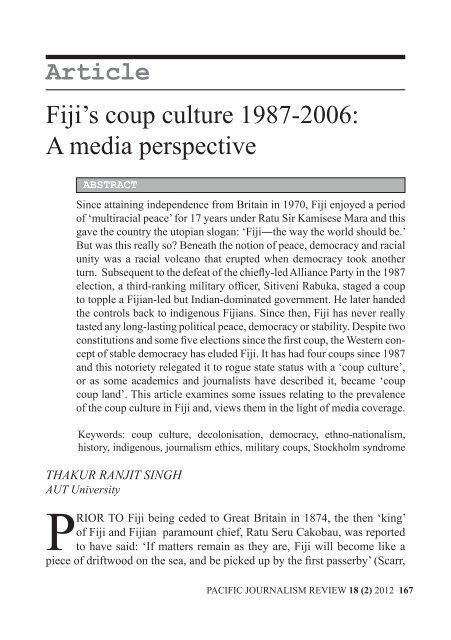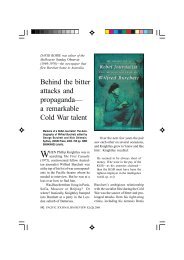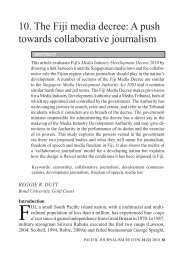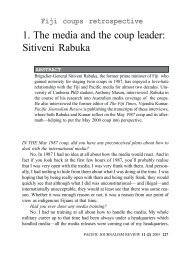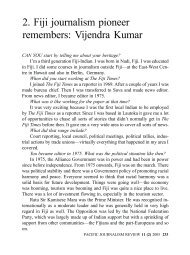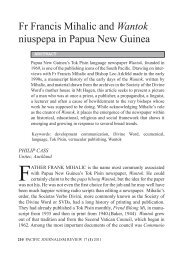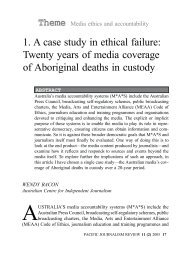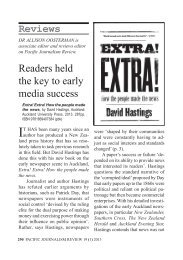Article Fiji's coup culture 1987-2006 - Pacific Journalism Review
Article Fiji's coup culture 1987-2006 - Pacific Journalism Review
Article Fiji's coup culture 1987-2006 - Pacific Journalism Review
You also want an ePaper? Increase the reach of your titles
YUMPU automatically turns print PDFs into web optimized ePapers that Google loves.
<strong>Article</strong><br />
REBUILDING PUBLIC TRUST<br />
Fiji’s <strong>coup</strong> <strong>culture</strong> <strong>1987</strong>-<strong>2006</strong>:<br />
A media perspective<br />
ABSTRACT<br />
Since attaining independence from Britain in 1970, Fiji enjoyed a period<br />
of ‘multiracial peace’ for 17 years under Ratu Sir Kamisese Mara and this<br />
gave the country the utopian slogan: ‘Fiji―the way the world should be.’<br />
But was this really so? Beneath the notion of peace, democracy and racial<br />
unity was a racial volcano that erupted when democracy took another<br />
turn. Subsequent to the defeat of the chiefly-led Alliance Party in the <strong>1987</strong><br />
election, a third-ranking military officer, Sitiveni Rabuka, staged a <strong>coup</strong><br />
to topple a Fijian-led but Indian-dominated government. He later handed<br />
the controls back to indigenous Fijians. Since then, Fiji has never really<br />
tasted any long-lasting political peace, democracy or stability. Despite two<br />
constitutions and some five elections since the first <strong>coup</strong>, the Western concept<br />
of stable democracy has eluded Fiji. It has had four <strong>coup</strong>s since <strong>1987</strong><br />
and this notoriety relegated it to rogue state status with a ‘<strong>coup</strong> <strong>culture</strong>’,<br />
or as some academics and journalists have described it, became ‘<strong>coup</strong><br />
<strong>coup</strong> land’. This article examines some issues relating to the prevalence<br />
of the <strong>coup</strong> <strong>culture</strong> in Fiji and, views them in the light of media coverage.<br />
Keywords: <strong>coup</strong> <strong>culture</strong>, decolonisation, democracy, ethno-nationalism,<br />
history, indigenous, journalism ethics, military <strong>coup</strong>s, Stockholm syndrome<br />
THAKUR RANJIT SINGH<br />
AUT University<br />
PRIOR TO Fiji being ceded to Great Britain in 1874, the then ‘king’<br />
of Fiji and Fijian paramount chief, Ratu Seru Cakobau, was reported<br />
to have said: ‘If matters remain as they are, Fiji will become like a<br />
piece of driftwood on the sea, and be picked up by the first passerby’ (Scarr,<br />
PACIFIC JOURNALISM REVIEW 18 (2) 2012 167
REBUILDING PUBLIC TRUST<br />
1970, p. 123). It was this thought of Fiji going into undesirable hands, among<br />
others, that prompted Fijian chiefs to cede Fiji to Great Britain.<br />
Fiji became a British Crown Colony on 10 October 1874 when growing<br />
European pressure on Fijian land and labour and their entanglement<br />
in internal Fijian rivalry for power and political ascendancy forced<br />
the self-styled Tui Viti, Ratu Seru Cakobau, to cede Fiji Islands to the<br />
United Kingdom. (Lal, 2010, p. 67)<br />
Lal (2010) refers to this as an unconditional transfer that was solemnised in<br />
the ‘Deed of Cession’ which outlined what chiefs had ceded or did not cede<br />
to the Crown, and how and in what way Fijian interests would remain ‘paramount’<br />
in Fiji (p. 67). It was the Independence Order of 1970 which formally<br />
brought this cession to an end nearly a century later.<br />
The early history suggests that Melanesian Fijians were fierce fighting<br />
people who had strong tribal affiliations and loyalties, and who had experience<br />
in espionage and <strong>coup</strong>s to take over the ruling of the islands. And that<br />
tendency appeared to have lingered on.<br />
It seems this cultural trait came into action when the Fijian chiefs lost<br />
power in <strong>1987</strong>. The early history of the Fijians, sees their regimes littered<br />
with episodes of tribal wars, <strong>coup</strong>s and counter <strong>coup</strong>s. Therefore one would<br />
not be incorrect in suggesting the term ‘<strong>coup</strong> <strong>culture</strong>’ for Fiji, as indeed it had<br />
been part of the Fijian <strong>culture</strong> long before the arrival of the missionaries and<br />
Christianity in the 18th and 19th centuries. In that spirit, this article also adopts<br />
the term ‘<strong>coup</strong> <strong>culture</strong>’ which is deemed appropriate given the prevalence of<br />
<strong>coup</strong>s in the early history of the indigenous Fijians.<br />
This article examines the reasons for a <strong>coup</strong> <strong>culture</strong> in Fiji and attempts<br />
to dig slightly deeper to try to fathom how a greater degree of analytical<br />
journalism may have been able to provide the underlying reasons for the fall<br />
of democracy in Fiji to military <strong>coup</strong>s since <strong>1987</strong>.<br />
The <strong>1987</strong> Coups: Sitiveni Rabuka<br />
Hansard records for ‘treason at ten’ on 14 May <strong>1987</strong> documented the following,<br />
just as one Member of Parliament who had the floor asked the speaker:<br />
‘How much time do I have, Sir,’ and the reply came ‘Press on regardless’<br />
when masked soldiers came into the Parliament:<br />
168 PACIFIC JOURNALISM REVIEW 18 (2) 2012
REBUILDING PUBLIC TRUST<br />
Sit down everybody, sit down. This is a take-over. Ladies and gentlemen,<br />
this is a military take-over. We apologise for any inconvenience<br />
caused. You are requested to stay cool, stay down and listen to what<br />
we are going to tell you. Please stay calm, ladies and gentlemen. Mr<br />
Prime Minister, please lead your team down to the right. Policeman,<br />
keep the passage clear. Stay down, remain calm. Mr Prime Minister,<br />
Sir, will you lead your team now.’ (Scarr, 1988, p. 70)<br />
Robie (1989) summed up that the demise of democracy in Fiji actually took<br />
place at 10.04 am, 14 May <strong>1987</strong> on an otherwise auspicious day. It was the<br />
108th anniversary of the first arrival of the indentured Indian labourers who,<br />
in a twist of irony, were looking for a new life of hope (p. 219).<br />
Then editor of The Fiji Times, Vijendra Kumar (2004) has also related<br />
his experience. He was in Raki Raki in the western part of Viti Levu when<br />
he heard the news over the radio. He rushed back to the office, attended the<br />
press conference where the reason for the <strong>coup</strong> was given as an act by the<br />
military to stop wholesale violence in Fiji by militant groups. The Fiji Times<br />
was published next day, but was shut down after the following day, 16 May<br />
<strong>1987</strong>. Robie (2004) tells of the humiliation of Kumar when he was led out of<br />
the office of the paper at gunpoint, and this was related by one of his staff,<br />
Eroni Volavola, a sports reporter (later to become media officer for Fiji’s Lands<br />
Transport Authority) who then was in the army’s Territorial Force. (p. 96).<br />
After shutting down for a month, The Fiji Times resumed publishing with very<br />
controlled news. (The Fiji Sun, the other daily, did not meet the same fate. It<br />
closed down for good, as it refused to operate under any form of censorship).<br />
After continuous harassment for four years, Kumar (2004) decided to leave<br />
Fiji and settled in Brisbane, Australia (p. 323).<br />
Robie (1989) in his book Blood on their Banner had been critical of the<br />
local media during the Rabuka regime in and after the <strong>1987</strong> event. A subheading<br />
in a chapter: ‘A compromised media’ is self-evident that media was seen<br />
to be wanting (pp. 238-241). While the military under Rabuka was negotiating<br />
for huge military expansion under French aid and a soft loan, including<br />
planned construction of a naval base and purchase of helicopters as part of<br />
the surveillance division, sections of the Fiji media bypassed such major<br />
developments as not news and little was reported. What was ironic was that<br />
somebody who had committed treason in Fiji for preserving indigenous rights<br />
was alienating Kanaks and Tahitian nationalists through his ‘marriage’ with<br />
PACIFIC JOURNALISM REVIEW 18 (2) 2012 169
REBUILDING PUBLIC TRUST<br />
the French government, which was then denying its indigenous people the<br />
right of self-determination (p. 238). Even the allegations that French aid was<br />
diverted to the military failed to attract the attention of the Fiji media. Robie<br />
was critical of the sections of the Fiji media for allegedly compromising the<br />
principles of journalism:<br />
It is indicative of just how complete was Rabuka’s control and manipulation<br />
on the news media that these developments passed generally<br />
without comment or criticism. The Fijian news media, particularly<br />
Radio Fiji and the vernacular newspaper Nai Lalakai (part of The Fiji<br />
Times), justified the military build-up as a measure to counter supposed<br />
internal and external threats. In one Nai Lalakai article prepared by the<br />
military, democracy was dismissed as ‘trickery of the devil’ and the<br />
Fijians were urged to ignore the educated elite. (Robie, 1989, p. 239)<br />
Some senior Fijian journalists were named as alleged sympathisers and propagandists<br />
for the Taukei Movement while others were prepared to stick to the<br />
principles of fair journalism (Ibid). The old Fiji Sun, which decided to close<br />
down, was hailed as a brave paper that was prepared to stand up for truth<br />
and social justice. Rabuka not only manipulated and used media during the<br />
<strong>coup</strong>, but he began his <strong>coup</strong> with the use of the government’s information<br />
ministry’s news mechanism.<br />
The then Permanent Secretary for Information in the Fiji government,<br />
Peter Thomson (1999) relates a somewhat lighter and hilarious incident<br />
on the day of the <strong>coup</strong> when he was sharing grog (kava) in a nearby office<br />
which was next to Parliament. He saw soldiers and dismissed them as being<br />
on some sort of civil defence exercise. Later, while deep in conversation, the<br />
door of the office was kicked open and gas-masked soldiers burst into the<br />
room, formed half a circle around the open door and trained their guns on their<br />
stunned gathering. In stepped Lieutenant-Colonel Sitiveni Rabuka, wearing a<br />
grey lounge suit with sulu vakataga, polished military sandals and striped tie,<br />
and sporting a handlebar moustache. He asked for Peter Thomson, with the<br />
audience staring in stunned silence. When identified, Thomson was directed<br />
back to his office and Rabuka ordered him to issue a press release. He related<br />
that Rabuka dictated while his fingers flew across the paper,<br />
The Royal Fiji Military Forces have taken control of the Fiji government<br />
to prevent any further disturbance and bloodshed in the country.<br />
170 PACIFIC JOURNALISM REVIEW 18 (2) 2012
REBUILDING PUBLIC TRUST<br />
I am on my way to Government House to seek recognition. I ask the<br />
public to remain calm and continue with their daily work. In particular,<br />
I ask that Fijian community do not take advantage of the situation.<br />
(Thomson, 1989, p. 13)<br />
This message was broadcast on Radio Fiji and circulated to other media outlets.<br />
So was revived the <strong>coup</strong> <strong>culture</strong>, an action that was last carried out by<br />
Seru Cakobau in 1830s to take control from his opponents. Unbeknown to<br />
all, this was to be repeated over and over again, and would be adopted as the<br />
term applied today—the <strong>coup</strong> <strong>culture</strong> of Fiji.<br />
Did Rabuka have any other way in May <strong>1987</strong>?<br />
Subsequent to the <strong>coup</strong> that Rabuka executed in <strong>1987</strong>, he wrote his first<br />
book, No Other Way and gave the reasons why he did what he did—as he had<br />
no other way. From an analytical perspective, did he have any other way in<br />
<strong>1987</strong>?<br />
Perhaps with the benefit of hindsight, it can now be confidently said that<br />
Rabuka and the military would have been right if they were ready to crush<br />
Fijian nationalism and tribalism in <strong>1987</strong> to instil respect for the majority<br />
decision and democracy at an earlier stage in Fiji’s history. Succumbing to<br />
the nationalists’ demand was the first step in giving credence to the Fijian<br />
<strong>coup</strong> prevalent during the 1800s where might was seen as right. The Bavadra<br />
government, after one month in office was becoming popular and already<br />
attracting support from all quarters. If the military had the will, like the then<br />
Commander, Ratu Epeli Nailatikau (now the President of Fiji) to support<br />
democracy, Fiji’s history may have been quite different today. Some commentators<br />
even speculated that Fiji may have been comparable to the Asian<br />
tigers, such as Thailand, Malaysia, South Korea, Taiwan and Singapore. But,<br />
as has been suspected all along, Rabuka’s aim was to give Fiji back to the<br />
Fijian chiefs, especially the eastern chiefs in the Alliance Party who had just<br />
lost an election and majority support.<br />
Had Rabuka allowed his military commander to support democracy and<br />
provide security from the internal threats to the Bavadra government, then<br />
perhaps he would have been instrumental in avoiding the 2000 Speight <strong>coup</strong>,<br />
and the current Bainimarama <strong>coup</strong> where the military is doing exactly what<br />
Rabuka’s excuse was for executing the <strong>1987</strong> <strong>coup</strong>. Rabuka’s action in <strong>1987</strong><br />
was ammunition for people like Speight and the chiefs who supported him,<br />
PACIFIC JOURNALISM REVIEW 18 (2) 2012 171
REBUILDING PUBLIC TRUST<br />
who thought if Rabuka did it in <strong>1987</strong> and gained handsomely through his<br />
treasonous act, then why should they not try to achieve a similar result. Naidu<br />
(2007) of the University of the South <strong>Pacific</strong> (USP) agrees that what Speight<br />
did was imitate Rabuka but failed because of the lack of support from the<br />
military and the chiefs (p. 33). Robie (2000) agreed that while both Rabuka<br />
and Speight had conducted both <strong>coup</strong>s for ‘indigenous Fijian supremacy’,<br />
Speight was out to finish the unfinished business of ‘Fijianisation’ of Fiji that<br />
Rabuka had failed to achieve (p. 2). Had Rabuka allowed history to take its<br />
course without military intervention, perhaps Bainimarama might not have<br />
been placed in a position as the new commander to act as he did after seeing<br />
the poor governance, corruption and racism under the guise of a democracy<br />
which the military was seen to be protecting, enhancing and promoting.<br />
Bainimarama may not have had to use the military against the Fijians, which<br />
was the reason for Rabuka to carry out his first <strong>coup</strong> in <strong>1987</strong>. It is now seen<br />
as an exercise in futility. The November 2000 mutiny, which many suspect<br />
was instigated by Rabuka along with the convicted Naitasiri chief Ratu Inoke<br />
Takiveikata and other chiefs, ended with eight soldiers and rebels being killed<br />
(Bhim, 2000, p. 128): ‘Altogether eight soldiers, two policeman and two rebels<br />
were killed in the <strong>coup</strong> and the mutiny of 2000’ (Naidu, p. 31). This led to so<br />
much division, bad blood and heartbreak in the army, which previously had<br />
been a sacred institution for the Fijian community.<br />
The current demise of the Great Council of Chiefs, curbing of the Methodist<br />
Church and the restructure and reform of other Fijian institutions is<br />
because of that early action by Rabuka in <strong>1987</strong>. If the Fijian military is today<br />
being used against the Fijians to crush their racism and ethno-nationalism, it<br />
is also because of his action.<br />
While history has demonstrated that he was wrong in <strong>1987</strong>, it also reveals<br />
after all, he had not been such a bad person. He had admitted, through his<br />
subsequent actions, that his ethno-nationalism of <strong>1987</strong> was wrong. He redeemed<br />
his <strong>coup</strong>s by siding with Jai Ram Reddy and the National Federation<br />
Party (NFP) in delivering Fiji the 1997 multiracial constitution. In his quest to<br />
promote and revive multiracialism, he sacrificed his political career by siding<br />
with an Indo-Fijian party (NFP). He was dumped and his chief-sponsored party,<br />
the SVT, lost heavily in the 1999 elections. The Fiji Labour Party (FLP) and<br />
its coalition partners were the beneficiaries and, consequently, they enjoyed a<br />
landslide victory. It is said that both the Fijians and the Indo-Fijians are now<br />
172 PACIFIC JOURNALISM REVIEW 18 (2) 2012
REBUILDING PUBLIC TRUST<br />
paying a heavy price for not embracing multiracialism when the Rabuka-Reddy<br />
team offered it to them during the 1999 elections. Both these leaders paid the<br />
ultimate price for experimenting with multiracialism because the people still<br />
voted on racial lines and dumped their respective parties. Jai Ram Reddy’s<br />
NFP failed to win a single seat.<br />
One of the architects of the 1997 Constitution, Professor Brij Lal (2010),<br />
summed this up in his book on Jai Ram Reddy, In the Eye of the Storm:<br />
Reddy understood Rabuka’s predicament and refused to take advantage<br />
of his numerous political misfortunes. Perhaps somewhere deep in his<br />
heart he even liked the man for who he was: sometimes misguided,<br />
sometimes evasive, a shrewd political animal, but essentially a decent,<br />
forgiving, warm-hearted human being. Had the Rabuka-Reddy political<br />
project succeeded, Fiji would almost certainly have been spared much<br />
of the agony and trauma it encountered in the years ahead. So while the<br />
Chief [Mara] and the Indian [Reddy] could not connect; the Commoner<br />
[Rabuka] and the Indian did. (Lal, 2010, p. 9)<br />
Rabuka and Reddy have both since retired from political life. Jai Ram Reddy<br />
now resides in Auckland, New Zealand, while Rabuka still lives in Fiji outside<br />
the political or leadership limelight.<br />
A racially-balanced military: Panacea to Fiji’s problems?<br />
The other issue relates to the composition, or rather the racial makeup of<br />
Fiji’s military. A question here relates to the reluctance of the Fijians and<br />
the British colonials to allow the Indians into the military. What might have<br />
been the history of Fiji if the Indians had been encouraged and even forced<br />
to join the army during the two world wars? The answer perhaps lies in the<br />
next question and answer.<br />
Why did Papua New Guinea and India, despite being so divided on regional,<br />
provincial, language, cultural and ethnic lines, have little chance of<br />
a successful racially-instituted or ethno-motivated military <strong>coup</strong> as Fiji did?<br />
The answer is because their military do not have the type of racial, ethnic,<br />
traditional or religious polarisation that Fiji military has. In those countries the<br />
diverse make-up of the soldiers would thwart, discourage and even prevent<br />
any uprising based on racial, religious and regional superiority.<br />
If the Fiji military in <strong>1987</strong> had, say 30 to 50 percent Indo-Fijian soldiers<br />
PACIFIC JOURNALISM REVIEW 18 (2) 2012 173
REBUILDING PUBLIC TRUST<br />
distributed equally in all the ranks, would Rabuka still have been able to topple<br />
the then Commander and institute a racially-motivated <strong>coup</strong>?<br />
The chances would have been slim, and may even have resulted in a<br />
mutiny as the comradeship in the military often transcends race, and a better<br />
alternative than treason could have been possible. In addition, it may have<br />
been difficult to keep such a plot secret in a racially-balanced army<br />
The bottom line is that, to remove the <strong>coup</strong> <strong>culture</strong> in Fiji, the military<br />
in Fiji should embark on racial balancing of the Fiji Military Forces and<br />
encourage Indo-Fijians to join military service. Such an exercise may be<br />
implemented over a long period of time based on natural attrition of the current<br />
soldiers in the army. There is no shortage of Indo-Fijians willing to join.<br />
The only problem is that, like in colonial days, they are not accepted, and<br />
in turn are blamed for lacking patriotism or the right physical build. On the<br />
excuse of smaller stature, tiny Ghurkhas and relatively smaller built Asian<br />
soldiers are competitive with heavily built ‘islanders’. Similarly, the slightly<br />
built Japanese soldiers during the Second World War created havoc among<br />
countries which had soldiers of bigger physical stature. What this means is<br />
that to possess military prowess and courage, size does not matter. For Fiji to<br />
deny Indo-Fijians recruitment in its military because of size and other reasons<br />
defies logic and historical backing.<br />
The absence of Indo-Fijians in the army was raised.... ‘Anybody can<br />
be accepted into the army,’ Colonel Paul Manueli, then head of the Fiji<br />
Military Forces, said. ‘But we do not provide special meals.’ It seemed<br />
a lame excuse, nothing more. Why not, it was asked, when exceptions<br />
were made for Fijians in other areas of public service? What about the<br />
Ghurkhas, it was asked, who did not eat beef? The message, distilled<br />
to its bare essence, was simple: that the Fijian—dominated Alliance<br />
party would never relinquish control of the military, or dilute the Fijians<br />
presence in it, which it saw as the ultimate bastion of power for the<br />
Fijian establishment. (Lal, 2010, p. 146)<br />
The adequacy of the 1970 and 1997 Constitutions<br />
This has been a persistent issue for decades because successive ethno-nationalists<br />
(including Sitiveni Rabuka, George Speight and their supporters)<br />
have used the excuse of the inadequacy of the 1970 and 1997 constitutions<br />
to carry out respective <strong>coup</strong>s against successive democratic governments.<br />
Claiming to carry out the <strong>coup</strong>s in the name of protecting Fijian interests,<br />
174 PACIFIC JOURNALISM REVIEW 18 (2) 2012
REBUILDING PUBLIC TRUST<br />
they fail to inform how these documents were defective or inadequate in<br />
protecting indigenous interests. This subject has also not been fully pursued<br />
through any media scrutiny or analysis, which is this article’s third issue for<br />
discussion.<br />
The preamble to Qarase’s 2005 ill-conceived Reconciliation, Tolerance<br />
and Unity Bill (RTU), as cited by Singh (<strong>2006</strong>) read:<br />
And whereas the political events of <strong>1987</strong> and 2000 were occasioned by<br />
a widespread belief among indigenous Fijians that the 1970 and 1997<br />
Constitutions were inadequate effectively to protect and preserve their<br />
rights and interests, their values, traditions, customs, way of life and<br />
economic wellbeing ... (Singh, <strong>2006</strong>, p. 357)<br />
In fact, Qarase was trying to pass a law based on misrepresentation and this<br />
thinking has been used in the past to rationalise and justify the <strong>coup</strong>s of <strong>1987</strong><br />
and 2000. It is evident that the Fiji media have not dug deeper to find out the<br />
truth. This practice of the Qarase regime to ought to have been scrutinised<br />
by the Fiji media.<br />
Sir Vijay R. Singh, the first Indo-Fijian knight and statesman and former<br />
Attorney-General in Ratu Mara’s Alliance government, raised some valid<br />
questions:<br />
Is it ever possible to reach an enduring agreement with Fijians on any<br />
important issue? Or will they renounce every solemn settlement whenever<br />
the next false prophet emerges from the woodworks? (Singh, <strong>2006</strong>)<br />
The historical and founding constitution (1970) after independence was arrived<br />
at after free negotiations and with the consent of all the stakeholders.<br />
It was not only unanimously approved by the Great Council of Chiefs but<br />
also endorsed by the British government on behalf of the Crown. The Fijian<br />
chiefs, including Ratu George Cakobau and Losalini Dovi, the two nominees<br />
of the Great Council of Chiefs and the Legislative Council unanimously approved<br />
the 1970 Constitution when it was tabled for formal consideration.<br />
Lal (2010) cited Jai Ram Reddy, the former Leader of the Opposition, and<br />
the NFP through a speech Reddy delivered in Cuvu, Sigatoka, during the NFP<br />
Convention address of 1981. In allaying fears about the security of Fijian land<br />
and the protection provided by the 1970 Constitution, Reddy said:<br />
PACIFIC JOURNALISM REVIEW 18 (2) 2012 175
REBUILDING PUBLIC TRUST<br />
And the supreme law of the land is the Constitution of Fiji. That<br />
Constitution protects the ownership of all land and especially Fijian<br />
land in a way which is probably unique in the world. Section 63 of the<br />
Constitution states that any law affecting Fijian land cannot be changed<br />
unless two-thirds of the members of the House of Representatives and<br />
the Senate and six out of eight nominees of the Great Council of Chiefs<br />
vote in favour of the change. In other words, three nominees of the Great<br />
Council of Chiefs can veto any proposed change. (Lal, 2010, p. 179)<br />
Several paradoxes about the <strong>coup</strong>s were never corrected by Fiji media. The<br />
1970 Constitution was good, acceptable, safe and very suitable in the 17<br />
years during the rule of Ratu Mara’s Alliance Party. Yet it was only found<br />
to be deficient and defective when the Alliance lost power to Dr Bavadra in<br />
<strong>1987</strong> and the power shifted to the West.<br />
It took a third-ranking army officer, a commoner, Lieutenant-Colonel<br />
Sitiveni Rabuka, to tell the nation that the Constitution was defective. Sir Vijay<br />
Singh (<strong>2006</strong>) questions: Where were the Fijian political leaders, academics or<br />
their many institutions, including the Great Council of Chiefs? (p. 358). This<br />
paradox continues, because the Great Council of Chiefs supported Rabuka’s<br />
treasonous act without protest or objections after the event. Not only that,<br />
they made Rabuka, a commoner, the council’s life member. This honour had<br />
nerver been bestowed on anyone before.<br />
Now to the 1997 Constitution: This was approved by the Great Council<br />
of Chiefs. In addition to this the members of both the upper and the lower<br />
houses (the Parliament and the Senate) unanimously gave their approval. More<br />
importantly, all the Fijian members did so as well.<br />
It took a bankrupt and failed businessman, not even a full Fijian, to inform<br />
the Fijian people and their chiefs of the inadequacies of the unanimouslyapproved<br />
1997 Constitution that had brought an Indo-Fijian to the prime<br />
ministership. The Great Council of Chiefs, which has since being disbanded<br />
by Bainimarama as a institution imposed by the British, had supported both<br />
Speight’s as well as Rabuka’s respective <strong>coup</strong>s, hence losing its conventional<br />
apolitical, neutral and impartial stance.<br />
The question arises over the unethical practices of the Qarase regime<br />
which introduced a Reconciliation Bill that referred to the ‘widespread belief<br />
among the indigenous Fijians that the 1970 and the 1997 Constitutions were<br />
inadequate to protect and preserve’ Fijian heritage, including their land rights<br />
176 PACIFIC JOURNALISM REVIEW 18 (2) 2012
REBUILDING PUBLIC TRUST<br />
(p. 358). Qarase’s SDL government had a great deal to answer. Singh (<strong>2006</strong>)<br />
questioned how and when were:<br />
… those interests and rights threatened: Why and how the built-in protection<br />
of the 1970 and 1997 constitution was insufficient; what proposals<br />
had the Fijians made for the strengthening of those provisions etc?<br />
And equally importantly, how was the removal of Ratu Mara from the<br />
presidency a solution to the perceived problem? (Singh, <strong>2006</strong>, p. 358)<br />
Sir Vijay R. Singh, who had migrated to Brisbane, was supposed to launch<br />
his book in Suva in 2007 but was prevented from attending by the nationalist<br />
Taukei movement, the same supporters of Rabuka and Speight. Singh’s<br />
writing and views about the hypocrisy of the Fijian leadership had made him<br />
unpopular with those who still believed might was right.<br />
Fiji’s history is a testimony to the fact that no Indian has deprived a single<br />
native landowner of a square metre of his land. This, however, cannot be<br />
said of the Anglo-Saxon colonialists. Instead it was Chaudhry, an Indo-Fijian<br />
Prime Minister who gave them back schedule A and B land which the colonial<br />
rulers had converted into state land and the Fijians’ own leaders had for 130<br />
years retained as such.<br />
Among other things the purpose of bringing up this discussion was, as<br />
Singh’s (<strong>2006</strong>) quotes noted here had intended, ‘to stop the merchants of<br />
malice from spreading their litany of lies’ (p. 359).<br />
The merchants of malice continue to ply their wicked trade at every<br />
opportunity by maligning a whole race that is innocent of any wrongdoing<br />
against Fijian custom, tradition or their land. They need to be<br />
exposed to the cleansing light of truth; not tolerated in silence. (Singh,<br />
<strong>2006</strong>, p. 359)<br />
The purpose, in some small part, of this article, is to reveal the realities<br />
and show them in a light where they may never have been told by the Fiji<br />
media which lack analytical and investigative skills. It is not surprising that<br />
USP academic Professor Vijay Naidu has claimed that ‘Fiji has never been<br />
a real democracy, it has been characterised by a “façade” of democracy’<br />
(Naidu, 2007, p. 24).<br />
Fiji media and the <strong>2006</strong> military takeover<br />
One interesting point of discussion at this juncture is that generally media<br />
PACIFIC JOURNALISM REVIEW 18 (2) 2012 177
REBUILDING PUBLIC TRUST<br />
is referred to as the Fourth Estate, and one wonders where it was during all<br />
the time the military was challenging Qarase’s government. Should they not<br />
have been at the forefront of reporting for good governance and been more<br />
vigilant and questioning as they were during Chaudhry’s administration?<br />
Why had it gone mute? Was it because the media was controlled by Fijians<br />
and this power struggle was about Fijian control and a Fijian government and<br />
not an ‘Indian’ one?<br />
The military <strong>coup</strong>s d’état that the country has experienced over the<br />
last 20 years have been to Fiji’s detriment. Coups up till the current<br />
one [<strong>2006</strong>] were designed to maintain chiefly power and to promote<br />
narrow ethnic interests that benefitted elements of an aspirant ethnic<br />
Fijian middle class and its business allies. (Naidu, 2007, p. 33)<br />
There was much protest over the removal of the publishers of The Fiji Times<br />
and The Fiji Sun respectively. However, the Fiji media remained relatively<br />
quiet when the Deputy Director of Public Prosecutions was given his marching<br />
order, thus interfering in the post-<strong>coup</strong> judicial investigations. ‘The government<br />
blocked the renewal of the contract of Australian prosecutor Peter<br />
Ridgeway, who has been successful in obtaining convictions of several<br />
putsch supporters’ (Ibid, p. 31).This brings into question the role played by<br />
Fiji media in neither being analytical nor digging deeper on issues that were<br />
reportedly in play during Chaudhry’s rule when even the smallest of internal<br />
government issues were dug up and exposed by an active media (Singh,<br />
2011, p. 260).<br />
Chaudhry had lodged a long list of polling discrepancies, both for the 2001<br />
and <strong>2006</strong> elections (Chaudhry, 2007). To what extent did the media follow<br />
up to ensure Fiji had clean elections? How questioning were they of what the<br />
general public in the extremely long election queues saw as, an incompetent<br />
Supervisor of Elections office? What credibility did the overseas observer<br />
groups hold? Why did the international observer groups lack observers from<br />
India, Mauritius, Malaysia, Singapore and other Commonwealth countries<br />
going through ethnic, political and electoral issues and with similar historical<br />
backgrounds?<br />
In earlier discussion, some important issues were raised about the ‘merchants<br />
of malice’ who were propagating misinformation. To what extent did the<br />
media take its role to advise the Fijians about the safety provisions of the 1970<br />
178 PACIFIC JOURNALISM REVIEW 18 (2) 2012
REBUILDING PUBLIC TRUST<br />
and 1997 constitutions? To what extent did they attempt to correct the misinformation<br />
spread by the ethno-nationalist elements in racial hate-speeches?<br />
This author had given tips to the Fiji media on issues in relation to Qarase’s<br />
Duavata Initiative, the business arm of Qarase’s ruling SDL party and the<br />
affairs of the Fijian Holdings Limited where the elite Fijians were alleged to<br />
have profited from their strategic influential and leadership positions. However,<br />
it appears that the Fiji media had been reluctant to follow issues involving<br />
influential Fijians (Singh, 2011, pp. 243, 245-252).<br />
There have been numerous, especially Indo-Fijian, commentators, including<br />
Sir Vijay Singh, who have questioned the irrationality coming from<br />
respective Fijian regimes. What steps did the media take to pick up on issues<br />
and conduct some in-depth analytical and investigative reporting to keep in<br />
line a regime which was seen as abusing its democratically-acquired status<br />
and which Bainimarama saw as a reason to remove a supposedly democratic<br />
Qarase’s regime?<br />
An important question is whether the Fiji media, in particular the dominant<br />
Fiji Times, been more responsible, more impartial, more balanced, and,<br />
ultimately, more questioning and investigative, in raising the issues of poor<br />
governance practised by Qarase and his SDL government, would the December<br />
<strong>2006</strong> takeover by Bainimarama have been avoided? Various research on the Fiji<br />
media, especially The Fiji Times, as outlined below, does raise some questions.<br />
Conclusion<br />
Research conducted by scholars and academics on the Fiji media in general,<br />
and The Fiji Times in particular, found the media wanting. Devi (1992)<br />
analysed the coverage of Fiji’s 1992 general election under the racist 1990<br />
Constitution and did an analysis of The Fiji Times and Daily Post. Gounder<br />
(<strong>2006</strong>) undertook an analysis of The Fiji Times to show how the media generated<br />
animosity and tension between the major ethnic groups there. Gounder<br />
(<strong>2006</strong>) conducted research on the coverage of George Speight’s <strong>coup</strong> with<br />
content analysis of three print media and also ventured to gauge the Stockholm<br />
syndrome on reporters staying in Fiji’s Parliament while covering the<br />
Speight takeover. Kiran (2005) conducted an analysis of coverage of Fiji’s<br />
May 2000 political crisis by The Fiji Times. Obini (2000) analysed the news<br />
coverage by The Fiji Times leading up to George Speight’s putsch and the<br />
demise of the Chaudhry government. This author (Singh, 2011) carried out<br />
PACIFIC JOURNALISM REVIEW 18 (2) 2012 179
REBUILDING PUBLIC TRUST<br />
a further in-depth content analysis of The Fiji Times to determine what role,<br />
if any, the newspaper played leading up to Speight <strong>coup</strong> in 2000. The common<br />
thread in all these research papers and theses is that they all were critical<br />
of the stance of The Fiji Times, which lacked the analytical articles and<br />
investigative calibre that may have spared the country numerous man-made<br />
disasters.<br />
In a December 2010 symposium at USP, Professor Robie was cited by<br />
Shailendra Singh (2010) calling for greater responsibility of media in supporting<br />
democracy, a greater need for analytical articles and in-depth reporting and<br />
empowering the public through better reporting. While this was in the context<br />
of peace journalism and conflict resolution, such analytical and investigative<br />
reporting on the issues that have been covered above may have contributed<br />
to a better informed audience during the Fijian <strong>coup</strong>s.<br />
References<br />
Chaudhry, M. (2007). Tainted election. In J. Fraenkel & S. Firth (Eds.), From election<br />
to <strong>coup</strong> in Fiji: The <strong>2006</strong> campaign and its aftermath. (pp. 347-364). Canberra,<br />
Australia: ANU E Press/Asia <strong>Pacific</strong> Press; IPS.<br />
Devi, P. (1992). Print media in Fiji: Fostering democracy or ethnocracy? Fiji Institute<br />
of Applied Studies, Research Report No 2, Suva, Fiji.<br />
Gaunder, P. (<strong>2006</strong>). Media and peace: The Fiji example: Working paper No 14. Centre<br />
for Peace Studies, University of Auckland, Auckland, New Zealand.<br />
Gounder, C. (<strong>2006</strong>). The Fiji 2000 <strong>coup</strong>: A media analysis: Unpublished Master’s<br />
thesis. Auckland University of Technology Auckland, New Zealand.<br />
Kiran, S. S. (2005). An analysis of the reportage of Fiji’s May 2000 political crisis<br />
in The Fiji Times. Unpublished Master’s thesis. Department of Literature and<br />
Language, The University of the South <strong>Pacific</strong>, Suva, Fiji.<br />
Kumar, V. (2004). Goodbye to paradise. In B. V. Lal (Ed.), Bittersweet: The Indo-<br />
Fijian experience (pp. 323-336). Canberra, Australia: Pandanus Books.<br />
Lal, B. V. (2010). In the eye of the storm: Jai Ram Reddy and the politics of postcolonial<br />
Fiji. Canberra, Australia: ANU E Press.<br />
Naidu, V. (2007). Coups in Fiji: Seesawing democratic multiracialism and ethnonationalist<br />
extremism. Devforum, 26: 24-33.<br />
Obini, N. (2000). Coup 2000: Responsible journalism: The Fiji Times?. Unpublished<br />
thesis. Centre for Development Studies, Department of Sociology, University of<br />
the South <strong>Pacific</strong>, Suva, Fiji.<br />
Robie, D. (1989). Blood on their banner: Nationalist struggles in the South <strong>Pacific</strong>.<br />
Leichhardt, NSW., Australia: Pluto Press.<br />
Robie, D. (2000). Taukei takeover: The media anatomy of a <strong>coup</strong>. Australian <strong>Journalism</strong><br />
<strong>Review</strong>, 22(2), 1-16.<br />
180 PACIFIC JOURNALISM REVIEW 18 (2) 2012
REBUILDING PUBLIC TRUST<br />
Robie, D. (2004). Mekim nius: South <strong>Pacific</strong> media, politics and education. Suva, Fiji<br />
Islands: USP Book Centre; AUT Press: South <strong>Pacific</strong> Books.<br />
Scarr, D. (1970). Cakobau and Ma’afu: Contenders for pre-eminence in Fiji. In J.<br />
W. Davidson & D. Scarr (Eds.), <strong>Pacific</strong> islands portraits (pp. 95-126). Canberra,<br />
Australia: Australian National University Press.<br />
Scarr, D. (1988). Fiji: Politics of illusion. Kensington N.S.W., Australia: New South<br />
Wales University Press.<br />
Singh, S. (2010). Media educator calls for ‘watchdog plus’ role to boost democracy.<br />
Retrieved October 20, 2010, from <strong>Pacific</strong> Media Centre http://www.pmc.aut.<br />
ac.nz/articles/media-educator-calls-%E2%80%98watchdog-plus%E2%80%99-<br />
role-boost-democracy<br />
Singh, S. V. R. (<strong>2006</strong>). Merchants of malice. In S. V. R. Singh (Ed.), Speaking out:<br />
Commentary on political, social and economic issues in Fiji during the decade<br />
1995-2005 (pp. 357-361). Canberra, A.C. T. Australia: Knightbrook Publications.<br />
Singh, T. R. (2011) The 2000 Speight <strong>coup</strong> in Fiji: An analysis of the role of The Fiji<br />
Times and the impact of partisan media: Unpublished Master’s thesis, Auckland,<br />
New Zealand: School of Communication Studies, AUT University.<br />
Thomson, P. (1999). Kava in the blood: A personal and political memoir from the<br />
heart of Fiji. Auckland, New Zealand: Tandem Press.<br />
Thakur Ranjit Singh is 2009/2010 AUT/<strong>Pacific</strong> Islands Media Association<br />
(PIMA) Pasifika Postgraduate scholar in communication Studies. He is former<br />
a publisher of Fiji’s Daily Post newspaper. This is a modified version of<br />
a paper he originally presented at AUT’s Media, Investigative <strong>Journalism</strong><br />
and Technology (MIJT) conference on 5/6 December 2010 at AUT University,<br />
Auckland, New Zealand.<br />
thakurji@xtra.co.nz<br />
PACIFIC JOURNALISM REVIEW 18 (2) 2012 181
Copyright of <strong>Pacific</strong> <strong>Journalism</strong> <strong>Review</strong> is the property of Auckland University of Technology and its content<br />
may not be copied or emailed to multiple sites or posted to a listserv without the copyright holder's express<br />
written permission. However, users may print, download, or email articles for individual use.<br />
http://www.aut.ac.nz/depts/commstud/journ/pjrsubs.shtml


